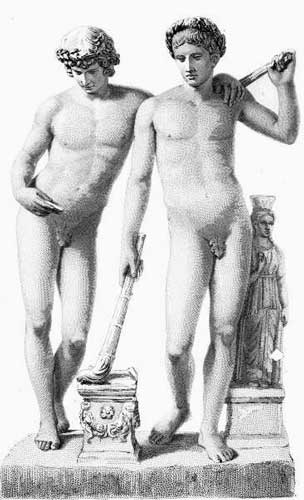.
Pasiteles (Πασιτέλης) was
a sculptor, the teacher of Colotes (Paus. i. 20. § 2). We know nothing further of him; and. in fact, we should be unable to distinguish him from the younger Pasiteles were it not for the almost decisive evidence that the Colotes here referred to was the same as the Colotes who was contemporary with Pheidias . Some writers, as Heyne, Hirt, and Müller, imagine only one Pasiteles, and two artists named Colotes, but Thiersch (Epochen, p. 295) attempts to get over the difficulty by reading Πραξιτέλου and -η for Πασιτέλου, &c., in the passage of Pausanias. It is true that the names are often confounded; but the emendation does not remove the difficulty, which lies in the fact that Colotes was contemporary with Pheidias; besides, it is opposed to the critical canon, Lectio insolentior, &c.
-------------------
Pasiteles, a Greek sculptor from South Italy (Magna Graecia), mentioned by Pliny the Elder. Since 89 BC a Roman citizen. Author of "Famous Works Throughout the World", a five books work about art.
He worked during a period where there was a demand for copies of, or variations on, noted works of Greek sculpture: the demand was met by the workshops of Pasiteles and his pupils Stephanus and Menelaus and others, several of whose statues are extant.
He was a native of Magna Graecia, and obtained the Roman citizenship, with his countrymen when he must have been very young, since he made statues for the temple of Juno, in the portico of Octavia, which was built out of the Dalmatic spoils, in B. C. 33; so that he must have flourished from about 60 to about 30 BC (Plin. H. N. xxxvi. .5. s. 4. §§ 10, 12). This agrees very well with Pliny's statement, in another place, that he flourished about the time of Pompey the Great (H. N. xxxiii. 12. s. 55).
Pasiteles was evidently one of the most distinguished of the Greek artists who flourished it Rome during the period of the revival of art. It is recorded of him, by his contemporary Varro, that he never executed any work of which he had not previously made a complete model, and that he called the plastic art the mother of statuary in all its branches (Laudat [M. Varro] et Pasitelem, qui plasticem matrem caelaturae et statuariae scalpturaeque esse dixit, et cum esset in omnibus his summus, nihil unquam fecit antequam finxit : Pliny, H. N. xxxv. 12. s. 45). Pliny tells us of an incident which proves the care with which Pasiteles studied from nature : as he was sitting in front of the cage of a lion, which he was copying on silver, he was nearby killed by a panther, which broke loose from a neighbouring cage (H. N. xxxvi. 5. s. 4. § 12). He is mentioned with distinction, in the lists of the silver-chasers and sculptors, by Pliny, who says that he executed very many works, but that the names of them were not recorded. The only work of his which Pliny mentions by name is the ivory statue of Jupiter, in the temple of Marcellus (l. c § 10).
Pasiteles occupies also an important place among the writers of art. He was the author of five books upon the celebrated works of sculpture and chasing in the whole world (quinque volumina nobilium operum in toto orbe; Plin. l. c. § 12), which Pliny calls mirabilia opera, and which he used as one of his chief authorities Elench. lib. xxxiii. xxxvi.). He stood also at the head of a school of artists, as we find from extant inscriptions, which mention Stephanus, the disciple of Pasiteles, and Menelaus the disciple of Stephanus.
The MSS. of Pliny vary between the readings Pasiteles and Praxiteles in the passages quoted, in consequence of the well-known habit of writing x for s. (See Oberlin, Praef ad Tac. vol. i. p. xv.) Sillig has shown that Pasiteles is the true reading, in some excellent remarks upon this artist, in the Amalthea, vol. iii. pp. 293-297. This correction being made also in a passage of Cicero (de Divin. i. 36), we obtain another important testimony respecting our artist; and we learn that in one of his silver-chasings he represented the prodigy which indicated the future renown of the infant Roscius as an actor. The true reading of this passage was first pointed out by Winckelmann (Gesch. d. Kunst, B. ix. c. 3. § 18).

San Ildefonso Group, Madrid Prado, (Maybe Hypnos and Thanatos, or Orestes and Pylades or the Dioscouri, maybe a work of students of Pasiteles. It was discovered in the Ludovisi Villa 1623 in Rome, was sold to Queen Christina of Sweden around 1664 and in 1724 it was given to King Philip V of Spain.
| Ancient Greece
Science, Technology , Medicine , Warfare, , Biographies , Life , Cities/Places/Maps , Arts , Literature , Philosophy ,Olympics, Mythology , History , Images Medieval Greece / Byzantine Empire Science, Technology, Arts, , Warfare , Literature, Biographies, Icons, History Modern Greece Cities, Islands, Regions, Fauna/Flora ,Biographies , History , Warfare, Science/Technology, Literature, Music , Arts , Film/Actors , Sport , Fashion --- |
Retrieved from "http://en.wikipedia.org"
All text is available under the terms of the GNU Free Documentation License


